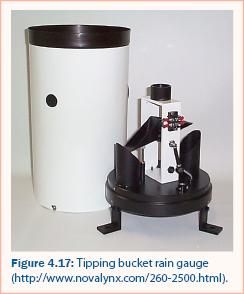
Rainfall
A.J. Erickson, J.S. Gulliver, R.M. Hozalski, O. Mohseni, J.L. Nieber, B.N. Wilson, P.T. Weiss
Rainfall measurement is an important aspect of any stormwater treatment practice assessment program, especially for monitoring. Rainfall data is collected in many locations (e.g., airports), but rainfall amounts and intensities can vary significantly over short distances, especially in regions where atmospheric convection cells are common. Therefore, to ensure an accurate and complete water budget, onsite rainfall measurement is recommended. For capacity testing (level 2 assessment) or synthetic runoff testing (level 3), rainfall measurement results can be used in conjunction with capacity or synthetic runoff testing results and a watershed model to estimate the long-term performance of a stormwater treatment practice. For monitoring (level 4), rainfall measurement is required for an accurate estimate of the rainfall water budget component.
Rainfall data provide an accurate account of the amount of rain that falls directly on the stormwater treatment practice and its drainage area. Rain falling on a stormwater treatment practice is not measured by the influent discharge measurement device (e.g., weir, probe, etc.) but may constitute a significant portion of water entering the stormwater treatment practice, depending on watershed and stormwater treatment practice characteristics.
Several tools are available for rainfall measurement, ranging from the simple depth measurement rain gauge to the more advanced tipping bucket rain gauges that record depth and intensity with a data logger. Depth rain gauges require prompt recording of the rainfall depth to avoid any loss due to evaporation or spillage, and tipping bucket rain gauges may require calibration. All rainfall measurement equipment should be installed according to the manufacturer’s instructions and maintained regularly to ensure accurate measurements.
Compared to depth rain gauges, tipping bucket rain gauges (figure 4.17) are a more accurate measurement of incremental rainfall because measurements are recorded near continuously with a data logger. Prompt inspection and recording of depth measurements can make depth rain gauges an accurate method of total rainfall measurement, as long as the depth rain gauge is readily accessible.

Recommendations
It is recommended that rainfall be measured at each location in which monitoring (level 4) is conducted. For small drainage areas, a single rain gauge is sufficient, but larger watersheds will require multiple gauges. Manufacturer recommendations or hydrologic texts (Bedient and Huber 1992) and manuals can provide additional guidance on spacing and placement of rainfall gauges.
Accurate rainfall measurement can be achieved in several ways. Depth rain gauges can measure total rainfall for individual storm events inexpensively but require prompt inspection and measurement recording to be accurate. To ensure timely measurements of rainfall depth and intensity, it is recommended that a tipping bucket rain gauge with a data logger be used.
Continue to Sampling Methods.